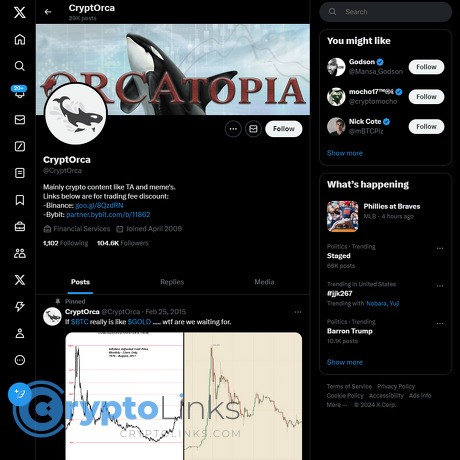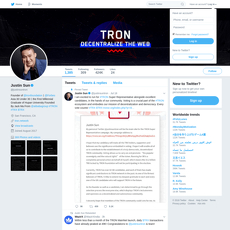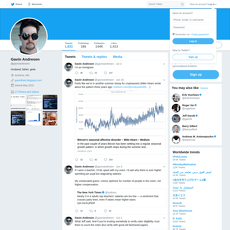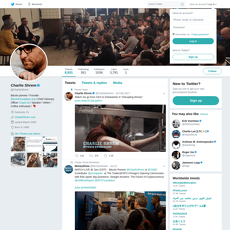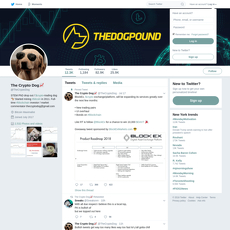CryptOrca Review
CryptOrca
x.com
CryptOrca Review Guide: Everything You Need To Know (X/Twitter) + FAQ
Thinking about following CryptOrca on X but not sure if it’s actually worth your time?
Here’s the straight answer: you can absolutely use accounts like @CryptOrca to find ideas—but only if you run a clean process. In this guide, I’ll show you what to expect from the feed, how I judge the quality of any crypto X account, and simple rules to protect your capital while still catching good moves.
The goal for you is simple: cut through noise, avoid common traps, and turn social content into a practical, low-stress game plan.
The common problems when following crypto accounts
Social feeds can help, but they can also nudge you into rushed, bad decisions. Here are the usual traps I see every week:
- Signal vs. noise fatigue: Timelines are full of hot takes, overlapping narratives, and vanilla memes. It’s hard to spot what’s actionable. Attention-driven buying is a known risk—research shows retail investors who react to attention spikes tend to underperform (Barber & Odean).
- Paid promos and undisclosed bags: Threads that “just happened” to post before a pop, or cheerleading with no disclosure. Watch for tiny #ad, “partnered,” or “advisor” mentions. If it looks like a billboard, treat it like one.
- Fast calls with no risk context: “Sending,” “we’re early,” “this can 10x” without entries, invalidation, or sizing guidance. That’s not a trade—it's a story.
- Copy trading without a plan: New traders chase someone else’s conviction, enter late, skip stops, then blame the messenger. You need your own timing and risk rules, always.
Rule of thumb: If I can’t see the where, when, and what invalidates—I pass.
Here’s a real pattern to keep in mind:
- The “pre-CEX whisper” setup: A small-cap gets teased as “close to a listing” in a thread. Price rips 25% on thin books. Retail chases the green candle. Two hours later, early wallets unload and price round-trips. If a post doesn’t spell out liquidity, market cap, and risk levels, you’re being fed FOMO, not edge.
There’s also data behind the urge to chase: attention shocks and social buzz can move flows in the short term—but those reactions often reverse just as fast. Studies on attention and trading underperformance apply just as much in crypto, where volatility magnifies mistakes (Trading Is Hazardous to Your Wealth). Your edge is in process, not speed.
What I promise in this guide
- A structured way to evaluate @CryptOrca’s content and credibility—and how I apply the same lens to any crypto account.
- Practical, low-friction steps to use social posts safely without becoming glued to the feed.
- Tools and habits that help you minimize risk and actually track results (not just vibes).
- A quick FAQ with wallet and security answers people keep asking about.
How I review any crypto X account (my simple framework)
I run the same checklist for every “alpha” or trading account. It’s fast and ruthless:
Transparency
- Disclosures: Do they clearly mark sponsors, affiliates, or advisor roles? Look for #ad, “sponsored,” or “partner” in-post—not hidden in a bio.
- Conflicts: If they talk a bag they hold, do they say so? Silence is a red flag.
- Behavior tells: Sudden narrative flips right before unlocks or listings with no explanation usually mean promo or pressure.
Track record
- Receipts: Are there dated charts, levels, and follow-ups? Wins and losses? I want post-trade notes like “stopped out at X” as much as “tp1 hit.”
- Verification tips: Use X Advanced Search: from:CryptOrca stop OR invalidated OR “tp” OR “cut”. Bookmark threads and grab screenshots with timestamps. If calls vanish, that’s information.
- Consistency: A steady cadence of updates beats cherry-picked victory laps.
Education vs. hype
- Process clues: Do they explain the “why”—market structure, catalysts, liquidity, funding, on-chain flows—or just post moon emojis?
- Actionable context: Entries, invalidations, timeframes, and what would change the thesis. If you can’t pull a plan from a post, it’s entertainment.
Risk guidance
- Stops and sizing: Even rough guidelines like “risk 0.5–1% per idea” or “avoid market orders on illiquid pairs” show they care about survivability.
- Timing: Notes on unlocks, listings, emissions, or macro events. No timing = higher trap risk.
- Warnings: Good accounts tell you when not to touch something.
Community value
- Spaces with replays: Consistent agendas and speakers you can check later—great for learning and accountability.
- Tools/threads: Watchlists, scanners, or checklists you can reuse. Memes are fun; reusable frameworks are value.
- Replies that help: Thoughtful answers in comments beat “gm” and “send it.”
Finally, a few fast rules that keep you safe while still catching good ideas:
- Only act on posts with levels and invalidation. If the post lacks a “where you’re wrong,” it’s marketing.
- Start small, scale only on confirmation. Half-size on the first tag; add only if your levels hold.
- Use limit orders and alerts. If it ran 10% from the post, let it go. FOMO is a tax.
- Log everything. Date, ticker, entry, invalidation, and outcome. Clarity beats memory.
So, where does @CryptOrca land on this scale? What content shows up most often, and how often do you get clear entries, invalidations, or follow-ups?
Up next: I’ll show you what you’ll actually see on the feed—frequency, content mix, and the post types that are worth your attention. Curious which ones are gold and which ones to skip?
What is CryptOrca? The basics, the feed, and what you’ll actually see
Open x.com/CryptOrca and you’ll land on a trading-forward feed that’s built for people who want levels, bias, and a sense of what narratives are heating up right now. It’s not lifestyle fluff. Expect a steady rhythm of charts, short market takes, and quick-hit notes that flag where liquidity is moving.
On a typical market week, here’s the flow I see most often:
- Market commentary: intraday bias like “risk-on/risk-off” reads, session ranges, or where BTC dominance might push alts.
- Charts with levels: screenshots calling out key HTF/LTF levels, reclaim/loss zones, and “invalidation” lines.
- Narratives and rotations: mentions of themes like AI, RWA, DePIN, modular L2s, or memecoins when volume says they’re in play.
- Watchlists: short lists of tickers with prices/levels to watch before New York open, Asia open, or around key data prints (CPI/FOMC).
- Community interactions: replies to chart questions, quote-tweets on catalysts, and occasional Spaces with other traders or builders.
When volatility spikes, activity usually picks up; during chop, you’ll often see more patience, higher time-frame charts, or “no trade” notes. That balance is what matters to me—timing a post around actual trading hours and liquidity conditions is a subtle but strong signal of intent.
“Process first, profits later. The market pays the patient.”
Content types to watch for
Not all posts are created equal. These are the buckets that consistently deliver value when I’m scanning any trading account like CryptOrca’s:
Market takes
What it looks like: “BTC 4h: reclaim 68.2k → 69.4/70.8k; invalidation below 67.3k. If DXY pops, stand down.”
Why it helps: You get a clear bias with specific levels. It’s actionable without being a blind signal. If it’s paired with context (e.g., funding, OI, upcoming unlocks), even better.
Education
What it looks like: short threads on using VWAP, why range re-tests matter, or a quick guide to confirming rotations with open interest and spot/perp deltas. Tool shout-outs (TradingView, Coinalyze, DeFiLlama, Token Terminal) are a plus.
Why it helps: You compound skills, not just followers. Studies on “attention-driven buying” (Barber & Odean, 2008) show how hype can distort decisions—education cuts through that bias.
Signals or watchlists
What it looks like: “Watch: OP 2.92 reclaim → 3.10/3.25, invalidation 2.84. ARB if BTC holds weekly open. FET on AI strength only.”
Why it helps: Great watchlists frame both entry and invalidation. If exits or timeframes are vague, treat them as ideas to test, not trades to copy.
Community posts
What it looks like: polls on which narrative leads next (AI vs. RWA), quick AMAs, or Spaces recordings with timestamps and tickers discussed.
Why it helps: Fast crowd read. Research on social sentiment and returns (Bollen et al., 2011; Sprenger et al., 2014) shows that real-time chatter can front-run short-term flows—use it as a nudge, not a trigger.
Signs of quality vs. red flags
Great trading feeds make your decisions easier. Low-quality ones make you emotional. Here’s how I separate the two at a glance:
Quality signals
- Timestamps + levels: before-the-fact charts with price, timeframe, key zones, and a clear invalidation.
- Follow-ups: post-trade updates—“stopped out,” “took partials,” “re-entered on retest.” No cherry-picking.
- Context: adds funding, OI, or liquidity cues; calls out catalyst risk (listings, unlocks, tokenomics changes).
- Consistency: similar format over time. If you can scan a post and know the structure, it’s a good sign.
Red flags
- “Next 100x” spam and vague moon targets without risk or timing.
- Screenshots without context: cropped PnL, unlabeled charts, or mystery indicators.
- Undisclosed promos: shortened links hiding referral codes, cheerleading for illiquid coins right before big sell walls, or “early gem” posts posted at odd hours with coordinated bot replies.
How to spot a promotion in disguise:
- Look for disclosure tags like #ad, “partner,” or “sponsored.” If missing, expand any shortened links (use a URL expander) to see tracking/referral IDs.
- Check the replies. A burst of low-effort “gem” comments from brand-new accounts is a classic shill pattern.
- Match the timing against volume/liquidity on explorers and aggregators. If a post lands right before a pool gets seeded or while depth is thin, treat it as high risk.
Who gets the most value by following
Active traders
You’ll benefit from the speed and structure. If you can set alerts, pre-plan invalidations, and avoid chasing 10% candles, the levels and watchlists can plug straight into your workflow.
Builders and researchers
Narrative pings are gold for idea sourcing. Turn mentions like “modular rollups” or “RWA yields” into a research queue with links to Messari, Token Terminal, and on-chain dashboards. You’re not trading every note—you’re mapping the next quarter.
Long‑term holders
You’ll get the most from higher time-frame charts and macro notes—use them to avoid FOMO buys and to frame DCA around weekly levels or catalyst windows. Skip the scalp noise.
Quick sample format I like to see and save:
- Setup: “SOL 4h range: 184–203. Reclaim 203 → 212/224. Invalidation: 198 close.”
- Why: “Funding cooled; perp delta flipped positive; BTC dominance stalling.”
- Plan: “Alerts at 202.8 and 198.2. No chase on breakout; retest only.”
When a feed keeps giving you that kind of clarity, your own process gets faster and calmer. And calm is an edge.
Curious whether the person behind these posts is consistent and accountable—or just good at timing the timeline? Keep reading; I’ll show you how I verify it in a way you can reuse for any crypto X account.
Is CryptOrca legit? My credibility checks you can run yourself
I can’t see anyone’s wallet, including CryptOrca’s. What I can see—and what matters—is behavior that repeats: consistency, honesty, and the paper trail. If you’ve ever been burned by a “sure thing” on X, you know the feeling. That’s why I use simple, public checks to decide whether an account earns my time.
“In markets, conviction is rented. Risk is owned by you.”
Below is the exact checklist I use to answer the question people actually care about: is CryptOrca legit? You can run every step yourself in minutes.
Track record and transparency
I’m not impressed by a single big win. I’m impressed by clean receipts, follow-ups, and losses owned in public. Here’s how I check that:
- Build a time-stamped ledger of calls: Use X’s advanced search to surface trade ideas with context.
- x.com/search-advanced
- Examples to paste:
- from:CryptOrca (setup OR entry OR invalidation OR stop) -filter:retweets since:2024-01-01
- from:CryptOrca SOL (above OR break OR reclaim) since:2024-01-01
- from:CryptOrca “watchlist” -filter:replies
- Recreate the trade, then grade it: Open TradingView, mark the entry, target, and invalidation the post mentions. Did price hit the invalidation? If yes, did a stop-out update appear on X? If not, that’s a yellow flag.
- Archive first, then judge: Screenshots get memory-holed; archives don’t. Save key posts with archive.today or Wayback, and roll threads with Thread Reader. I bookmark wins and losses equally so I’m not fooled by cherry-picks.
- Look for disclosures when it matters: Sponsored posts or affiliations should be stated plainly (words like ad, partner, sponsored). Lack of clear disclosure around paid mentions conflicts with FTC guidance and erodes trust fast.
- Check the ratio of follow-ups to fresh calls: A quality feed closes the loop. If a setup is shared publicly, I expect a public outcome—especially when it fails. No post-mortems? That’s not “alpha,” that’s marketing.
Real example you can test: If you see a post like “SOL reclaiming $150 is my trigger; invalidation $142; target $165,” pull the chart. Did SOL visit $142? Was there a stop update? Did a later post note the outcome either way? You’re not judging the win rate—you’re judging the honesty of reporting.
Why this matters: Studies show attention and confident language often drive engagement more than accuracy. See Barber & Odean’s work on attention-driven buying (SSRN) and research on social-media sentiment shaping markets (Bollen et al., arXiv). I want receipts, not rhetoric.
Engagement quality
Hype is loud. Quality is specific. I look for signs that the account respects your capital:
- Replies that teach: Do they answer tough questions on liquidity, unlocks, and invalidations? Or do they dodge with memes? Open the replies under a setup and scan for real context.
- Spaces with structure: Good Spaces have agendas, recurring formats, and opposing views—not echo chambers. If CryptOrca hosts, I want to hear risks discussed as plainly as the upside.
- Healthy network effects: Who regularly retweets or co-hosts with them? If credible analysts, researchers, or builders engage thoughtfully, that’s a green sign. If it’s mostly low-effort shill accounts, expect promo pressure.
- Language patterns: High-certainty claims paired with vague entries is a classic red flag. Strong opinions are fine; weak process isn’t.
One more nudge from research: accuracy “nudges” increase truthfulness on social media (Pennycook & Rand, 2019). If you see consistent clarifications, risk caveats, and post-trade notes, that’s an organic nudge—they care about accuracy.
Independent validation steps
Even if a call sounds great, I don’t act until I’ve verified the underlying claims. Here’s the fast workflow I run on anything mentioned by CryptOrca (or any account):
- Cross-check the narrative:
- Protocol updates: Messari, Token Terminal, team blogs, GitHub commits.
- L2 status or roadmap: L2Beat.
- News verification: official X accounts, press releases, reputable outlets (not screenshots of Telegram).
- Check on-chain and liquidity:
- Holders and top wallets: Etherscan (or relevant explorer) Token page → Holders tab. Look for concentrated ownership, vesting wallets, and multi-sig details.
- Liquidity and real volume: Dexscreener or GeckoTerminal. Small pools with thin depth are widow-makers.
- Contract safety quick-scan (for small caps):
- Token permissions: TokenSniffer, GoPlus Security.
- Owner controls: mint, blacklist, trading pause, proxy upgradability, tax. If any of these are mutable, size down or pass.
- Extra caution on new launches: rug risk remains real; see documented pump-and-dump patterns in crypto (Hamrick et al.).
- Listing status: Is it only on one DEX with a $50k pool? Hard pass for most accounts. If it’s on majors (Binance, Coinbase, Kraken) or top DEXs with deep pools, you can consider wider sizing—after you confirm the thesis.
The one-minute audit I actually run before I care about a call:
- Claim confirmed on official sources? Yes/No
- Liquidity ≥ $1M and daily volume ≥ $1M? Yes/No
- Top 10 holders < 60% combined and team/multisig transparent? Yes/No
- Contract can’t mint/blacklist or upgrade at will? Yes/No
- Clear invalidation level I can execute? Yes/No
If I get two “No” answers, it goes to the watchlist, not the wallet.
Last note on psychology: attention is a trading factor all by itself. Barber & Odean showed retail investors tend to buy what grabs attention, not what’s best (SSRN). Social feeds amplify that. My checks are built to slow me down, not speed me up.
So—if you confirm these habits on CryptOrca’s feed (clean timestamps, honest follow-ups, real disclosures, and respect for risk), you’ve got a green light to keep listening. Want the exact system I use to turn a single post into an executable plan—without chasing a +10% candle or getting wicked out? That’s next.
How to follow CryptOrca without getting wrecked
Good ideas don’t make money. Good execution does. The goal here is simple: use what you see on CryptOrca without getting pulled into FOMO, overtrading, or blind copying. You’ll set up a clean feed, turn tweets into concrete plans, and run a risk stack that protects the downside.
“The market rewards discipline, not urgency.”
Set up your feed like a pro
Most people lose not because they’re wrong, but because their feed is chaos. Structure beats willpower. Here’s how I set it up so I catch the signal and skip the noise.
- Create a dedicated X List: Make a List called Trade Ideas. Add CryptOrca and a few high-quality market accounts only. No memes, no news spam. Check this List on a schedule:
- 08:00–08:15 UTC (EU open prep)
- 12:00–12:15 UTC (midday scan)
- 19:00–19:15 UTC (US session overlap)
Why: Scheduled checks reduce impulsive entries and “scroll trading.” Research shows frequent trading correlates with worse performance (see Barber & Odean’s Journal of Finance study, “Trading Is Hazardous to Your Wealth”).
- Tune notifications on the account level: On CryptOrca’s profile → bell icon → enable Highlights or Tweets only. Then click the three-dot menu → Turn off Retweets. You want setups and context, not reply bait.
- Mute FOMO triggers: Settings → Privacy and Safety → Mute → add keywords:
- “next 100x”
- “last chance”
- “entry now”
- “don’t miss”
- “instant pump”
Why: You’re engineering your attention, not just your entries.
- Bookmark for learning, watchlist for trading:
- Bookmark educational threads and process notes. I clip them to Notion with a tag like Playbook.
- Watchlist actionable tickers in TradingView. Add notes from the tweet: price levels, invalidation, catalyst date.
Turn posts into a plan
If a tweet makes you want to buy now, that’s your cue to slow down. Convert every post into a 5-step plan. No plan, no trade.
- 1) One-sentence thesis: “SOL reclaiming 140 with funding reset; targeting 152–158 on weekly momentum.” If you can’t say it in one sentence, you don’t understand it.
- 2) Levels: Define entry, invalidation, and targets before touching the button.
- Example: Entry on 140.8–141.2 retest; invalidation 138.8; targets 152/158. Timeframe: 2–6 days.
- Use limit orders. Market orders in volatile names cost spread + slippage; that compounds over time (see slippage basics on Investopedia).
- 3) Liquidity check: For anything outside BTC/ETH and top majors:
- Confirm liquidity and volume: DexScreener (ETH, BSC), Birdeye (Solana).
- Derivatives and OI context: Coinalyze (funding, OI spikes).
- 4) Execution: Set alerts at the reclaim/retest level. Use OCO (one-cancels-other) to pair targets with stops. Don’t chase after a +10% candle; wait for your level or skip. Momentum without a plan is how accounts blow up.
- 5) Log it: Google Sheet columns: Date, Ticker, Entry, Invalidation, Size, R:R, Outcome, Notes. You’ll learn faster from 10 logged trades than from 100 random ones.
Paper test first: Track 2–3 weeks of ideas with a “virtual” balance. If the style fits your tempo and you can execute calmly, then allocate small real risk. This aligns with research showing that excessive live trading degrades returns for most investors (Barber & Odean).
Risk and tool stack
Edge is fragile. Protect it with sizing, confirmations, and awareness of catalysts.
- Position sizing rules (simple and strict):
- BTC/ETH: up to 5–10% per idea if you’re experienced; beginners keep it 2–5%.
- Top-20 majors: 2–4% per idea.
- Small caps/illiquid: 0.5–1% max. If you can’t exit in one candle without nasty slippage, size down again.
- Stop logic that makes sense:
- Place stops beyond structure, not “just below” the level everyone sees. Consider ATR for distance.
- If your stop is too wide for your size, your size is too big. Resize, don’t “hope.”
- There’s evidence that rule-based stops help reduce tail-risk blowups (Kaminski & Lo).
- On-chain and contract safety (for token calls):
- Contract risk scan: RugCheck (SOL), TokenSniffer (ETH), GoPlus.
- Check: verified contract, mint authority, trading taxes, LP lock, holder distribution (no whale >40%).
- No green lights? No trade. Never market buy a fresh contract because of a tweet.
- Volatility and confirmation tools:
- TradingView: mark levels, set alerts, use OCO if your exchange supports it.
- Coinalyze: watch funding flips and OI divergences to confirm or fade a move.
- LunarCrush: social spikes can front-run volatility—use as context, not a trigger.
- Catalyst timeline first, entry second:
- Check unlocks: TokenUnlocks. Big unlock this week? Tighten risk or wait.
- Event risk: CPI/FOMC, major listings, or protocol upgrades. Your plan should say “before/after catalyst” explicitly.
- Execution guardrails I actually use:
- No new positions during the first 15 minutes after a big headline or listing—spreads and slippage are worst here.
- Two-strike rule: if I miss my planned entry twice, I stop chasing and move on.
- One-click position cap on the exchange to block fat-finger oversizing.
When a post hits your feed, remember: your job isn’t to predict, it’s to manage risk and execute. Your future self will thank you for every trade you didn’t take out of urgency.
Curious which Spaces and threads are actually worth showing up for—and how to turn them into a practical watchlist in minutes? That’s where we go next…
Community value, Spaces, and extras: is there real edge here?
If the charts are the bait, the real catch is what happens around them: the Spaces, the threads, and the habits they build in you. That’s where a crypto X account either compounds your edge—or drains your attention. With CryptOrca, I pay close attention to the repeatable community value: structured conversations, clear recaps, and practical extras I can plug into my system fast.
“Edge isn’t a secret call. It’s the routine that helps you act when it counts—and ignore everything else.”
Spaces and threads worth showing up for
Not every Twitter/X Space is created equal. When I see CryptOrca host or join a Space, I look for signs it won’t waste my time:
- Recurring format with a clear agenda — e.g., “Rotations Radar, Wednesdays 14:00 UTC: 10m macro, 15m sector flows, 5m Q&A.” Consistency beats randomness.
- Timestamps and replays — a pinned recap thread with minute markers lets me jump straight to “L2 gas fees + Base memecoin flows (18:30)” instead of listening for 90 minutes.
- Speakers who build or ship — founders, protocol devs, on-chain analysts. Less guessing, more firsthand context.
- Explicit risk notes — “unlocks in 9 days,” “LP is thin,” “contract is upgradeable,” etc. If it’s all hype, I’m out.
- Follow-up threads — a next-day post with key levels, invalidation, and updated watchlist. This turns vibes into a plan.
Here’s how I translate a high-signal Space into action within 10 minutes:
- Snapshot watchlist — I jot down 3–5 tickers mentioned with a one-line thesis. Example:
- OP: “Sequencer revenue trending up; ETF chatter increasing L2 attention; invalidation below weekly 200MA.”
- RUNE: “CEX-outflow narrative; liquidity routing upgrades upcoming; watch $X.XX pivot.”
- TIA: “Modular compute meme regaining traction; catalysts: hackathon + ecosystem grants.”
- Convert to alerts — set one alert at the entry zone, one at invalidation, and a calendar note for catalysts (unlocks, votes, listings).
- Save the replay — I bookmark the Space and the recap thread so I can re-check claims before placing any real order.
Simple trick that keeps me sharp: I paste one quote that captures the Space’s core idea into my notes. If I can’t explain the thesis in a single sentence, I won’t touch the trade.
Measuring the value over time
Good community value compounds. The easiest way to spot it: track ideas, not vibes. I keep a lightweight “idea journal” for anything sourced from CryptOrca’s feed, Spaces, or threads:
- Date — when I heard it
- Source — Space, thread, or post (link)
- Ticker/sector — precise label (e.g., “AI infra,” “perp DEX”)
- One-line thesis — plain English logic
- Trigger + invalidation — level, time-based stop, or catalyst fail
- Size/risk — small, medium, or “majors only”
- Outcome — hit, miss, or passed; add R multiple if you trade it
- Clarity grade — A/B/C based on how actionable the original info was
Sample entries I’d expect from a strong feed:
- 2025-02-12 — Space replay (link). OP. “L2 flows + sequencer revenue.” Trigger: reclaim $X.XX on 4H close. Invalidation: -6% or back below weekly MA. Size: medium. Outcome: +1.8R. Clarity: A.
- 2025-02-20 — Thread (link). RUNE. “Routing upgrade next week; rising CEX outflows.” Trigger: pullback to demand. Invalidation: weekly low. Size: small (volatility). Outcome: missed entry. Clarity: B.
- 2025-03-01 — Space (live). Small-cap L2 tooling. “Low float; unlock in 12 days.” Trigger: none—watch only. Outcome: skipped (unlock risk). Clarity: A for risk callout.
After 3–4 weeks, patterns appear:
- Hit rate vs. R:R — I don’t care if hit rate is 40% if average winners are 2–3R and losers are cut fast.
- Timeliness — Are levels shared before or after the move?
- Clarity drift — If clarity grades slide and promos spike, I cut attention quickly.
It’s worth remembering how easily attention gets monetized against you. Research on investor behavior shows that “attention-grabbing” events can skew buying decisions toward whatever is loudest, not what’s best. See: Barber & Odean, “All That Glitters”. Your journal is the antidote—it makes you measure signal without the noise.
Paid groups, signals, and ethics
If CryptOrca ever offers paid signals or a private channel, I don’t judge by testimonials. I look for operating rules and ethics in plain sight:
- Method transparency — Is there a short, clear doc explaining the framework (timeframes, tools, risk rules), not just “we’re early”?
- No front-running — Hard rule: no positions entered before alerts are published. Bonus: a stated “publish-then-execute” window.
- Latency policy — If signals arrive after a 10% candle, I’m out. Give levels, not FOMO.
- Post-trade logs — Wins and losses posted with timestamps, not cherry-picked screenshots.
- Position sizing guidance — Clear ranges (“majors 1–3%, small-caps 0.25–0.5%”). No “all-in” culture.
- Easy exit — Transparent pricing, no lock-ins, and a trial you can paper trade before paying.
- Security hygiene — No wallet requests, no DMs for “special offers,” no off-platform payments to random addresses.
Red flags I won’t tolerate:
- “100x next” spam and rushed countdowns
- Undisclosed bags or sponsors tied to calls
- Deleted misses with only wins left on the timeline
When in doubt, I opt out. Paid or free, the standards don’t change: clear method, clean ethics, trackable outcomes. And always—this isn’t financial advice. It’s your capital, your rules.
One last thought before we go on: imagine pairing a high-signal narrative account with a small set of complementary sources so you cover macro, on-chain, and security without drowning in feeds. Want the exact lightweight mix I use and the resources that actually earn their keep?
Alternatives, complements, and helpful resources
No single X/Twitter account is “the edge.” You get consistent results by pairing fast narrative feeds with hard data, macro context, and a safety net. That mix cuts noise and helps you act on ideas with fewer blind spots.
Rule of thumb: one source = one bias. Many sources = cross-checks.
There’s a practical reason to do this. Forecasting research shows that combining independent views often reduces error compared to relying on any single forecaster. The Good Judgment Project also found that diverse teams using shared tracking can boost accuracy significantly. In plain English: balance hype with proof, and your decisions improve.
Smart complements
If you like following a narrative or alpha-style feed, match it with a light stack that covers different angles:
One macro analyst (bigger picture and liquidity)
- Lyn Alden – clear takes on liquidity, yields, and risk cycles.
- The Macro Compass – practical frameworks for bonds, USD, and growth/slowdown regimes.
One on-chain/data feed (confirmation and timing)
- Glassnode or CryptoQuant – exchange flows, realized profits, funding, SOPR.
- CoinGlass – open interest, liquidations, funding snapshots.
- DeFiLlama – chain/sector TVL trends to validate narratives.
- Token Terminal – revenue, fees, and users for “is this real adoption?” checks.
One security/wallet expert (stop preventable losses)
- WalletScrutiny – checks who can reproduce wallet builds.
- Revoke.cash – manage risky token approvals before they bite.
- Trail of Bits blog – great reads on common smart contract pitfalls.
- Chainlist – add the correct RPCs, avoid spoofed networks.
One builder-focused voice (what’s shipping, not just trending)
- L2Beat – objective risk framework for L2s and bridges.
- Paradigm Research – deep protocol/mechanism posts.
- Ethereum Research – where many ideas start.
- Flashbots – MEV and block market insights.
One healthy skeptic (keep your feet on the ground)
- Web3 is Going Great – quick reads on blow-ups and patterns to avoid.
- Bennett Tomlin – investigations and risk commentary.
That’s your balance: narratives for ideas, macro for context, data for confirmation, builders for what’s real, skeptics for brakes.
Resources I recommend
I keep my stack light so I actually use it. Here’s what earns a spot and why:
On-chain and market dashboards
- Glassnode / CryptoQuant – watch exchange netflows, miner flows, SOPR, and funding. Rising OI + positive funding into resistance = caution.
- CoinGlass – funding and liquidation heatmaps for timing late longs/shorts.
- Laevitas – options skew and term structure when majors dominate the tape.
- DeFiLlama – TVL by chain/sector; great for spotting rotations before headlines.
- Token Terminal – protocol revenue/users; filter hype that has no fees or DAU.
Narrative and research
- Messari – sector overviews and quarterly token reports.
- Galaxy Research – mining, ETFs, and structural themes.
- CoinShares Fund Flows – pro capital flows by asset, every week.
- a16z State of Crypto & Electric Capital Developer Report – dev activity and usage tend to correlate with durable ecosystems.
Safety and hygiene
- Revoke.cash & Etherscan Approvals – remove dangerous allowances.
- Chainabuse – community-reported scams and addresses.
- Scam Sniffer – wallet warnings and phishing alerts.
Catalysts and calendars
- TokenUnlocks – supply unlock timelines (plan size accordingly).
- CoinMarketCal – events and listings to anchor your watchlist.
- Binance Announcements – listings/margin changes that move flows.
- Arbitrum Gov Forum / Optimism Gov – incentive votes often front-run sector rotations.
Execution and tracking
- TradingView – alerts and clean journaling with chart snapshots.
- Simple sheet or Notion – log date, ticker, thesis, entry, invalidation, result. Over time, patterns jump out.
Why this works: research on investor behavior shows overtrading hurts returns (Barber & Odean). A small, rules-based stack curbs impulsive entries and forces verification. Pair that with a basic idea journal and your hit rate and discipline improve fast.
How I keep my list fresh
- Quarterly clean-up: mute or unfollow anything that turns into promos or pure hopium. I promote accounts that timestamp, state invalidations, and follow up on misses.
- Rank by signal, not fame: my personal scorecard is clarity (A/B/C), risk notes (Y/N), timeliness (fast/late), and honesty (post-mortems done?). Follower count doesn’t move the needle.
- 30-day trials: test new accounts and tools for a month. Keep what genuinely changes decisions; cut the rest.
- Mandatory skeptic slot: at least one source that challenges my thesis. It saves me from being the last buyer.
- Automate sanity checks: X Lists for “Trade Ideas,” “Macro,” “On-chain,” “Security.” Mute words like “100x,” “last chance,” “guaranteed.” You’ll be shocked how much stress disappears.
- Score your forecasts: even a light Brier score or win/loss tag improves accountability. Good Judgment research shows feedback loops materially improve accuracy over time.
Want the fast, no-BS answers people always ask next—like which hardware wallets are actually legit, how Tangem cards generate keys, or how to act on a post without overtrading? I’ve got that lined up right after this. Which one are you most curious about?
FAQ: quick answers people look for
Is CryptOrca a scam?
I don’t slap labels on people; I look at behavior. Here’s how I keep it simple and safe:
- Consistency: Do calls have levels, invalidations, and follow-ups? Or just victory laps?
- Transparency: Are sponsors/affiliations disclosed? Any “partnership” posts without clear tags are a flag.
- Receipts: Can you find dated posts for wins and losses? If old misses disappear, I scale down trust fast.
- Risk notes: If a post can move price (small caps especially), I expect cautions on liquidity, unlocks, and position size.
If you can’t verify these basics, reduce trust and risk. No creator gets a free pass with your capital.
How do I act on a post without overtrading?
Treat every post as research, not a buy/sell button. This is the simple system I use:
- One-sentence thesis: If I can’t explain why the trade exists in one line, I skip it.
- Defined risk upfront: Entry, invalidation, and size. No plan = no trade.
- Limit orders and alerts: I don’t chase green candles. I set alerts at the level I want.
- Two-tries rule: If I get stopped twice on the same idea, I walk away. No revenge trades.
- Tiny size on illiquid names: 0.25–0.5% per idea until I see depth and consistent volume.
Example: “If SOL reclaims $160 on volume and holds, I’ll enter with a stop at $154, risking 0.75% of my stack. Target $175–$182 into next catalyst.” If SOL fails to hold $160 or volume is weak, I do nothing.
Overtrading wrecks returns. There’s strong evidence that frequent traders underperform—see Barber & Odean’s study “Trading Is Hazardous to Your Wealth,” which found high-turnover investors lagged the market by ~6.5% annually. Social buzz can make it worse; Twitter sentiment has been shown to move crypto short term. Bottom line: keep a plan, not a pulse.
Is Cypherock legit?
Cypherock markets itself as a secure hardware wallet with audits by KeyLabs and a listing on WalletScrutiny. That’s a positive start. Before buying, I always:
- Check current audits: Confirm the latest report date and scope on the official site (cypherock.com). If there’s a security page, read it end to end (try /security).
- Verify openness: Is firmware reproducible? Any open-source components? Cross-check on WalletScrutiny.
- Supply chain: Buy direct, inspect seals, update firmware through official channels, and verify signatures/hashes when possible.
- Operational habits: Use a strong PIN/passphrase and test a small transfer first.
Tech is only half the story. Your setup and habits carry the rest of the risk.
How does a Tangem card work?
Tangem uses a secure element to generate a private key inside the card during activation. The key never leaves the card. A wallet set can include up to three cards (or a ring + two cards), and each card provides equal access—think identical keys to the same vault.
- Seedless by design: No written seed phrase unless you use optional features. Backups are additional cards.
- Security element: Tangem advertises Common Criteria–certified chips (they’ve referenced EAL6+ in marketing). Check their technology page and docs for current specs.
- Real-world tip: Store backup cards in separate locations, set a passcode, and test restore with a small amount before going all-in.
As with any hardware wallet, verify the app source, firmware authenticity, and only buy from the official store. Don’t tap unknown NFC readers, and keep NFC off on your phone when not in use.
Does CryptOrca have a token or paid group?
Impersonators love fake “tokens,” “VIP signals,” and airdrops. Here’s how I check:
- Official handle only: Confirm announcements on the real account: x.com/CryptOrca.
- Pinned post + bio: If there’s no mention there, it’s almost certainly fake.
- No DMs, no timers: Anyone pushing a countdown or wallet address in DMs is trying to rush you.
- Domain + signatures: If a site is linked, verify the domain in multiple posts and look for signed messages or on-chain verification.
For context, social-media-originated crypto scams are a major problem; the FTC has repeatedly warned about them (example report). Slow is smooth, smooth is safe.
Final take: should you follow?
If you value timely market notes and you already run your own process, following can help you find ideas faster. If you’re newer, treat the feed like a study guide: save posts, build your watchlist, and paper test for a couple of weeks before risking real money.
- Keep risk tight: Pre-define size and invalidation every time.
- Track outcomes: Simple journal: date, ticker, thesis, entry, invalidation, result.
- Unfollow ruthlessly: The moment content pushes you into FOMO or hides risk, cut it.
Nothing here is financial advice. Your edge is your process. The right accounts are just inputs—use them on your terms.
CryptoLinks.com does not endorse, promote, or associate with Twitter accounts that offer or imply unrealistic returns through potentially unethical practices. Our mission remains to guide the community toward safe, informed, and ethical participation in the cryptocurrency space. We urge our readers and the wider crypto community to remain vigilant, to conduct thorough research, and to always consider the broader implications of their investment choices.

